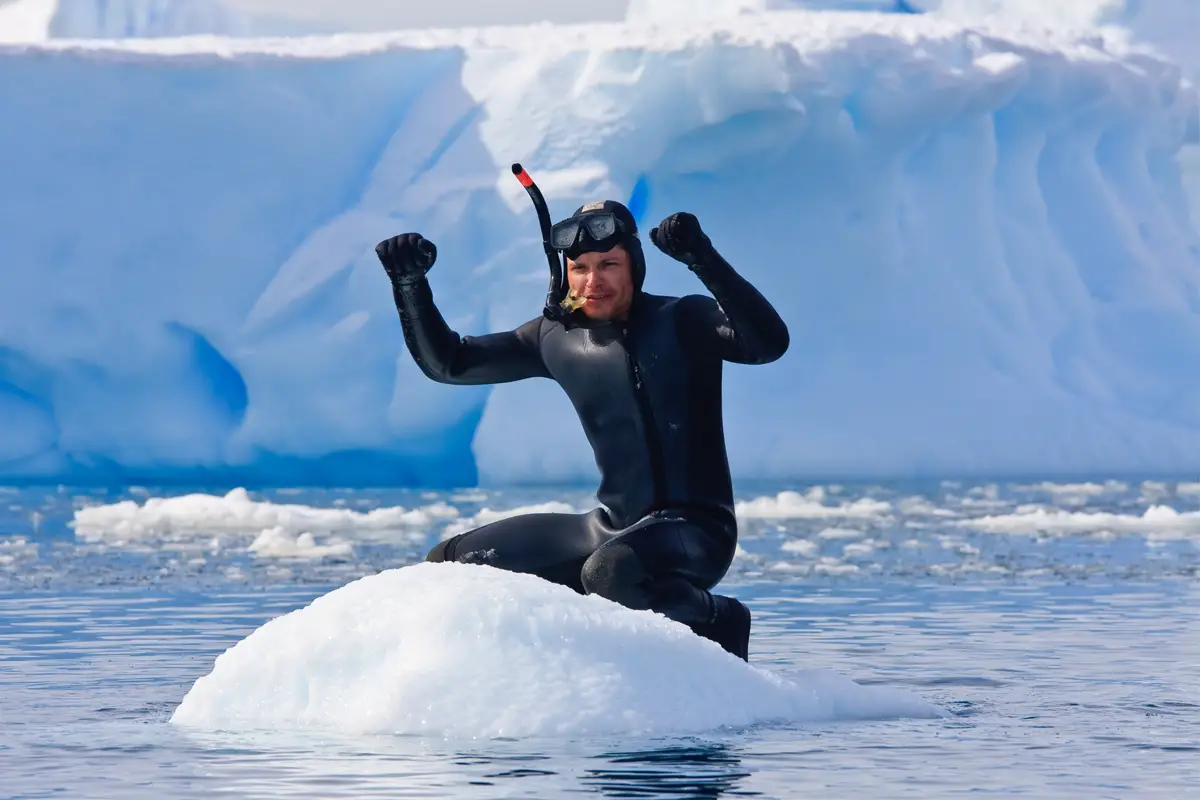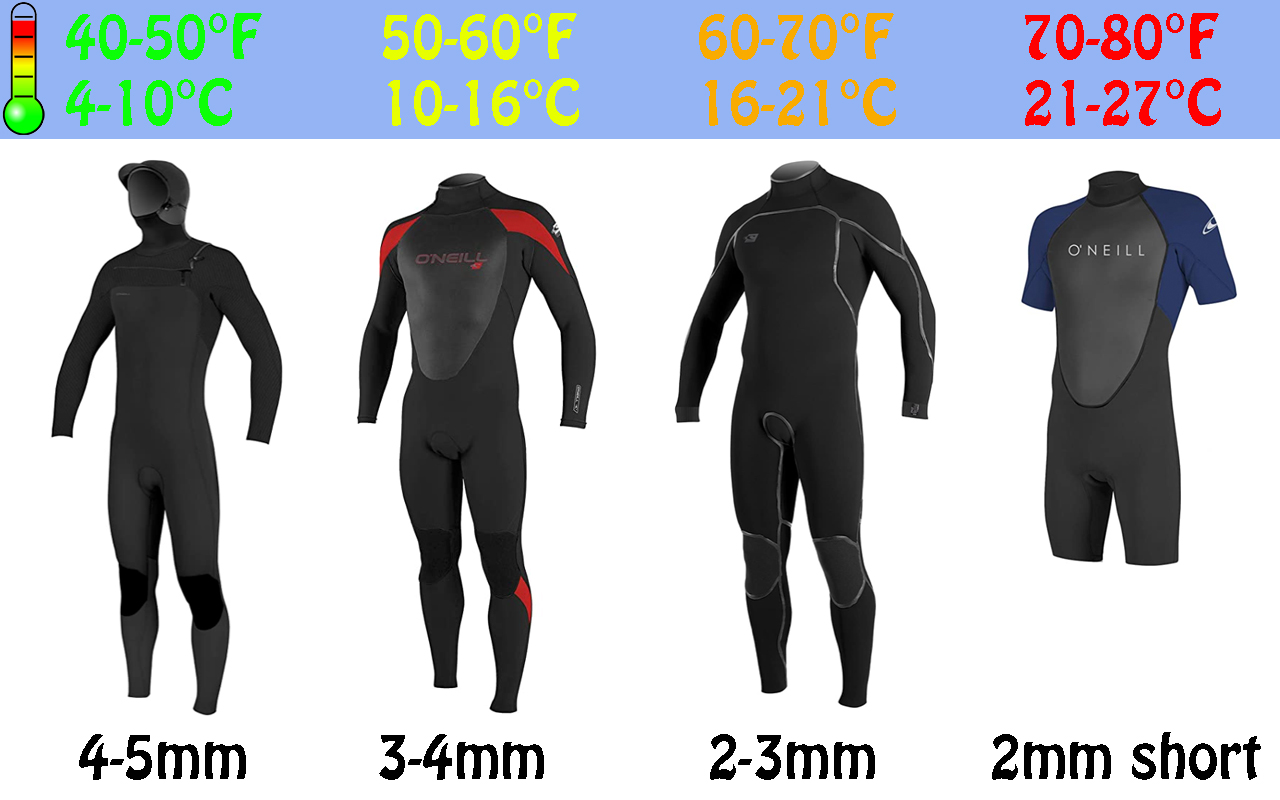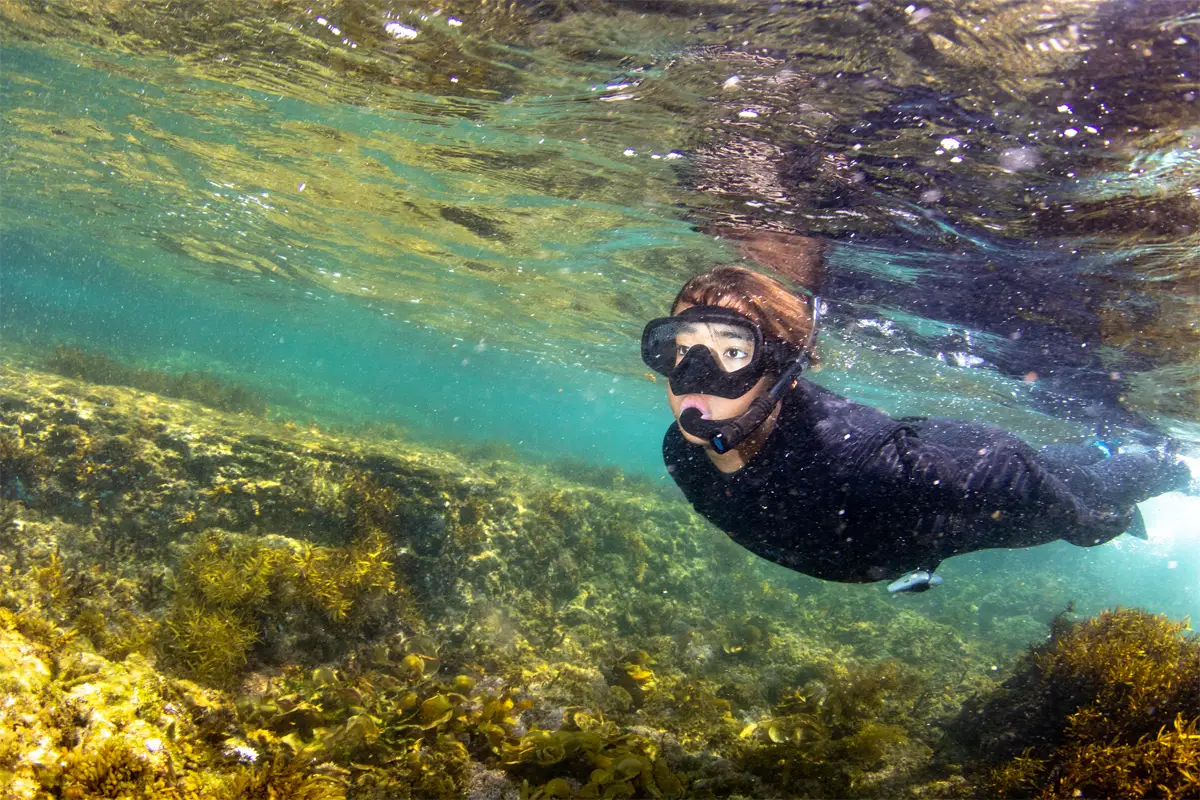
After writing my article “what to wear when snorkeling” a few days ago, I was having some doubts whether or not to add wetsuits. They’re not something you often see when visiting a white sandy beach on a holiday. However, there are quite some awesome beaches that probably require a wetsuit, like snorkeling in San Diego for example.
Let me start with something to remember: Wetsuits are meant to keep your body warm, especially in cold water. But here’s the thing: Everybody experiences temperatures differently. I personally feel cold pretty fast whilst my wife is the exact opposite. So yeah…how do you determine which wetsuit to get? It’s really not that simple! How thick should yours be? Do you need one with long or short sleeves? Will it fit your luggage? Is it easy to clean? Loads of stuff to think about before making a decision.
Thickness
To determine thickness, where is it you’ll be snorkeling? Is it always the same place or will you be traveling to different countries with different water temperatures? I guess it’s not a cheap hobby to buy a separate wetsuit for each and every continent. In other words: Figure out the water temperature, or the range of water temperatures you will be experiencing in a certain location. Also pay attention to the time of the year.
Cool, now that we have that “boring stuff” out of the way, let’s make this article more fun and easy to understand! What I did is simply read a whole bunch of reviews and (together with my own experience) come up with an “average wetsuit thickness idea“. Even though these are my “guessed averages”, some people prefer a thicker and others a thinner wetsuit. But if we cover the averages first, you at least have a global idea of what I’m talking about:

Obviously, the colder the water the thicker the wetsuit. The range I show you in the picture above is just a selection of temperature ranges. I once wrote an article about snorkeling in Silfra (Iceland) where the water temperatures can be cooler than 40°F (4°C) and might even be as low as 35°F (<2°C). So yes, there are thicker wetsuits (like 6mm for example). I just didn’t take extreme cold water into my chart, especially since so called “dry suits” could be better/necessary in (very) cold water. I don’t cover water temperatures above 80°F (27°C) in this article either since these temperatures are usually way more comfortable with a snorkel rash guard.
Another important thing: We snorkelers usually float on the ocean surface. Scuba divers however descend further down, which means colder water. That’s why scuba divers sometimes need a thicker wetsuit than snorkelers (like 7-8mm for example). Average sea temperatures can be found at seatemperature.org.
Long Or Short Sleeve?
It’s pretty straightforward that long sleeves will keep your body warmer than short sleeves, right? You probably want to consider one that comes with an attached hood. Long sleeves also provide a larger area of protection. And with protection I mean not only sunburns but also damage to the skin. Most fish prefer to stay close to rocks since they provide the necessary protection from predators. If you snorkel close to rocky areas you might hurt yourself. Some people find excitement in climbing a rock in order to enjoy the view. We all know to be careful, but wetsuits can protect you from nasty unexpected scratches or wounds.
When it comes to short sleeves (also known as spring suits), things get a little more personal. Someone could feel warm whilst someone else has the tendency to always feel cold. In warm water however it’s important to not overheat! When in doubt I always advise people to borrow or rent one for the day. This avoids unnecessary purchases. Remember, the temperatures I suggest in my above picture are an average that I calculated myself. It’s definitely not a true representation of “what everybody feels”. I snorkeled in warmer water without a wetsuit a whole bunch of times, and I still do so. My personal approach is this: When I’m in doubt, I just go snorkeling in “warm water” and see how it goes. If it’s all working out fine, well, that’s fine. If however the water temperature feels a little too cold, and if that forces me to quit my snorkel adventure sooner than expected, a short sleeve could do the trick. I hope you get what I’m trying to explain here.
How Should A Wetsuit Fit?
You want a close-fitting wetsuit. It should be tight, but not too tight. It should touch your skin as much as possible without being extremely tight. In the end it should still feel comfortable (and you want to forget about the fact that you have it on). Not as easy as one might think. Wetsuits tend to fit more easily after using them a few times, but not all manufacturers are the same.
If you decide to get a long sleeved version, make sure that the sleeves reach your wrist bone. For the legs, get one that reaches all the way to the ankle bone. Avoid empty spaces like gaps or rolls.
Important: There will be a layer or water between your body and your wetsuit. As long as this is a thin layer, your body is able to heat it up. As soon as water layers get too thick, the wetsuit won’t be able to do it’s job of keeping you warm.
Do You Wear Something Below A Wetsuit?
I always wear my swim trunks below my wetsuit and my wife uses her one-piece bathing suit. It’s all a matter of comfort. Some people experience discomfort whenever they wear a wetsuit, especially around the neck and below the armpits. Others feel irritation behind the knees. You can wear additional clothing for these areas (some even wear a rash guard). Just make sure you don’t wear cotton as it could irritate your skin (which leads to discomfort). Others prefer to wear nothing below their wetsuit, but if you rent or borrow one that’s maybe not the best idea.
What About Hands And Feet?
This is another very personal thing. No, I don’t think you need to grab a pair of gloves or shoes in order to stay warm. I mean, most of us wear snorkel fins anyway. Furthermore, having your hands free is comfortable! But yes, of course, if the water is extremely cold you probably need to think about these issues. Maybe even a hood will be necessary.
However, there are a few good reasons to grab some gloves or shoes. I won’t be repeating all the pro’s and con’s as I listed them in my snorkel gloves review which you can check out if you feel like it. And then there’s my water shoes review (even for people who wear fins but need some extra warmth or grip).
Are There Wetsuits For Kids?
There certainly are. The most common thickness is 2-3mm (I’ll link to a few further down below). Pay attention to the fact that kids grow, so maybe grabbing the most expensive one isn’t the best thing to do (unless you really need or want to). Most of them sell for around 20-30 bucks and, to make it more fun, they’re available in many different color combinations. If you’re thinking about getting one, check out the ones that come with sun protection UPF 50+. I still use separate sunscreen for my daughter, which I explain in my discussion about UV protection for snorkelers.
What Are The Downsides Of Wetsuits?
Diving
To answer this question it’s important to understand that a downside could just as well be an advantage for someone else. Let me explain. A wetsuit is made of neoprene. The thing is this: Neoprene floats. So if you have trouble to stay afloat while snorkeling, well yes, a wetsuit will help you out quite a bit. They save you energy so to speak. However, this also makes it harder to dive down in order to observe that colorful coral. As most of my readers know, I’m a big fan of snorkeling with a GoPro (link to my review). A wetsuit makes it much harder for me to dive down and to stay there for that perfect picture. Sure, snorkel fins can help (this links to my fins review), but it all takes quite some effort (and therefore energy).
I recently wrote an article about tankless diving for snorkelers where I cover gear that allows you to stay underwater for over an hour. I don’t own one of those myself, but I can imagine that people could get cold during that time. What I’m trying to say is that a wetsuit could help people out in a variety of ways.
Luggage
Another disadvantage is luggage. Dry wetsuits usually weigh around 3-4 pounds (1.5 – 2kg) but get even heavier when wet. I sometimes only bring hand luggage on a short trip (like I explained in my article about bringing snorkel gear on a plane). Sometimes you just need to be picky about what to take with you. But it’s not just weight. Wetsuits do require a good amount of space as well. In your luggage, on your way to the beach, maybe even in a bus or taxi. Some people bring a beach cart for soft sand with them, but if you don’t have one, think about this kind of stuff.
Neoprene Allergies
“Surfer Today” actually wrote a very helpful article about this on their website. Here’s the link to their article. The thing is this: Some people seem to be allergic to neoprene. They experience skin irritation or even swelling after putting on their wetsuit. The questions is: Will the shop accept a return after you tried it on? The “Surfer Today” website covers some common “why’s” and “how’s” which could be worth it to check out.
Cleaning
I’ll cover how to clean a wetsuit in just a moment, but yes, they need to be cleaned. They can be quite heavy when wet, which makes the process of cleaning not as easy as some might think.

How Much Is A Decent Wetsuit?
This depends on the manufacturer and on the thickness. My 2-3mm O’Neill wetsuits was like 200 bucks. They’re usually a little more expensive if you go thicker and a little cheaper if you go thinner. But let’s put the average O’Neill wetsuit somewhere between 150-350 bucks. Spring suits (short sleeves) are often cheaper, but still somewhere around 100 bucks or so (depending on the brand). Children sizes are cheaper in most cases. So yes, it’s all a matter of budget. There are cheaper ones out there for 50 bucks, I just can’t review them as I never tried them. But hey, who knows they’re just perfect! Especially if you’re not planning to use your wetsuit a lot.
How Do You Clean A Wetsuit?
A wetsuit needs to be cleaned after every snorkeling session. You can do this with tap water. Once in a while, especially if your suits starts to show some marks or starts to smell, an additional neoprene soap should be added to the water.
- Open the zipper of your wetsuit (if it has one)
- Wash your wetsuit with tap water. You can use a shower or you can fill a tub/bucket with water. Rinse your wetsuit so it gets rid of all the sand and salt from the ocean.
- Turn your wetsuit inside out and repeat the process. Make sure to massage your suit gently in case you prefer to clean it in a bucket of water.
- Make sure that the zipper is cleaned as well. With a shower that’s pretty simple, in a bucket you need to use your hands so the water reaches the area.
- After rinsing, close the zipper and leave your wetsuit to dry (still inside out) by using a plastic coat hanger (fold it halfway).
- Once the inside has dried, put your wetsuit back in it’s original shape (so not inside out anymore) and now leave the outside to dry as well.
Soap
It’s not necessary to use soap. However, once in a while it’ strongly recommended to clean your wetsuit more thoroughly. When you start to notice marks or strange smells, consider to grab a bottle of wetsuit cleaner. Grab a bucket (or use a bathtub) and fill it with water. Add the cleaner according to the manufacturer’s instructions. There should be instructions on how long you need to soak your wetsuit, but on average that’s about 15-30 minutes. Finally you clean your wetsuit like I explained before.
If you’re curious, I have a separate article about cleaning snorkel gear where I explain how to clean masks, snorkels and fins.
So How About Rash Guards?
Rash guards look pretty similar to wetsuits. However, they’re thinner and often made of nylon and spandex. They’re not really meant to keep you warm (even though they do so to a certain extent). People use them in warm water in order to protect their skin from UV rays, stings, scratches and sometimes even for safety (by getting a bright neon color). Furthermore, rash guards are usually cheaper than wetsuits. In my personal opinion they’re more comfortable to wear and easier to put on because of their stretching abilities. I wrote a separate review about snorkel rash guards for anyone interested.
Links To Stuff
For anyone interested in learning more about the products I mentioned in my article, here are a few helpful links (they all refer to Amazon with possible discounts):
The O’Neill wetsuits I showed you above are all listed here. They’re available for men and women in different color combinations. One thing I like about O’Neill is that they often have some of the best discounts.
The kids collection can be found here. Many colors and designs to choose from.
Wetsuit cleaner/shampoo is available by a variety of brands. You can find them all from this link.
